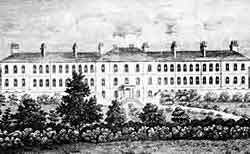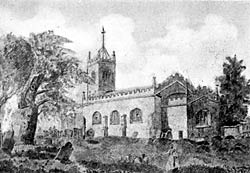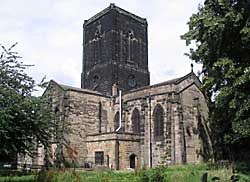 |
The Asylum, Sneinton. |
The Asylum. The Asylum for the Town and County was built in 1810-12, and with additions made in 1829 is stated to have cost £31,000, of which seven-twelfths were raised by voluntary contributions, four-twelfths by the county rates, and one-twelfth by Nottingham. Many costly extensions of buildings and lands and improvements of service took place, and in 1874 the Borough decided to sell out, and built an Asylum at Mapperley, whereupon £14,889 19s. 10d. was paid by the County for the Borough's share of the value of the land, buidings, engineering works, fixtures and furniture, and the County continued the use of the buildings and grounds until an Asylum for a greatly enlarged number of patients was built at Radcliffe, for which £140,000 was borrowed, and thereupon parts of the old building were pulled down, and part was sold for the Daykeyne Street Lads' Club. The estate realized £24,320, and the Corporation in 1908 purchased from the new owner about nine acres of it for a public park, at a cost of £14,960, being a little less than 6s. 10d. a yard, and £2,000 was spent in adaptation.
The Canal. The Nottingham Canal cuts through a small portion of the parish. There was great rejoicing when in 1793 it was opened. A new course for the Leen seems to have been cut (called in the award "the new river Leen") from "the old river Leen to the Trent," and which flows north-east of the new football ground.
The Luddite Riots. The Luddite Riots of one hundred years ago —that is the breaking of stocking frames with a view to better the condition of the workers—continued in Sneinton later than in many of the other villages affected. In 1812 a lace machine in the house of Mr. Glew, Earl Street, was destroyed in his presence. In 1814 frames were broken at Mr. Hooton's, Old Sneinton, and Mr. Cooper's, New Sneinton. The condition of the stocking makers was pitiable in the extreme, but the steps taken to improve matters were senseless, and advantage was taken of the state of affairs by ordinary criminals to rob and injure for their own pleasure. It is remarkable that secret committees, large rewards, and every precaution should have been unavailing, and not till the factory system came was the miserable custom of frame rents, "truck," and low wages removed.
The Reform Riots. The Reform Riots of 1881 had a little effect on Sneinton, for when the rioters proceeded to endeavour to destroy Colwick Hall, they, in going up Sneinton Road, armed themselves with the palisades of Notintone place, and so were able to go on with their senseless destruction of property, involving as it did the death of Mrs. Musters—Byron's Mary Chaworth.
Felons. ''The Association of Earl Manvers and his tenants for the prosecution of felons'" was, before the establishment of the police, a vigorous body, consisting of more than 100subscribers, residing in 23 parishes, of which Sneinton was one. There is a placard issued in 1882, offering 20 guineas (half by the tenant) as a, reward for the discovery of the slaughterer of a lamb near Radcliffe Ferry. They had an annual dinner at the "George," and here is their bill 70 years ago: Dinners for 20, £4; Dessert, 10/-; 8 Port, 44/-; 6 Madeira, 33/-; 4 Sherry, 22/-; Brandy, 2/8; Waiter, 5/-; £9 16s. 3d.—nearly 10/- each, of which the tenants paid 5/-each. At a farmers' dinner now little would be spent on wine, and more on beer and spirits, but even some farmers are learning that water is best.
Population. Sneinton must have been small in the olden times. In 1689 an assessment of 1/- in the £as a grant or levy for their Majesties William and Mary for the necessary defence of these "Realmes," produced £19 19s. 6d., showing the valuation to be about £400. There were 34 ratepayers.
The population was in 1801,558; 1851,8,440; 1901, 23,093, the numbers are now included in the city whole. The acreage appears as 911.
Workhouse. In 1834 the Poor Law authorities wanted to know what provision Sneinton had for the destitute poor, and it was answered that the parish rented 11 distinct buildings for the reception of the poor, in which there was room for 52 individuals, one of the buildings being large. They also subscribed to the Workhouse at Gedling, at 21/2 guineas per annum, and occasionally sent their poor. There were 10 individuals—5 adults and 5 children, at a cost together of 2/6 per head, per week, which included maintenance, clothes, and medicine. The Gedling Workhouse then stood at the end of Stoke lane. In 1839 Sneinton, Radford, and Lenton were formed into a Union, Richard Morley, of Sneinton, became chairman, and Radford superseded Gedling.
School Board. Only one School Board was elected for Sneinton, and that was in 1877. The members were Wm. Burgass (Chairman), Geo. Marsh (Vice-chairman), H. S. Cropper, S. Collishaw, E. Browne, T. Stevenson, John Webster, Canon Hutton. They built the large Schools west of the Church.
Local Board. The following gentlemen constituted the Sneinton Local Board when the parish was annexed to Nottingham in 1877:— Messrs. Nathan Pratt (Chairman;, George Allcock, W. Burgass, J. Crossland, Dr. J. Ellain, Samuel Eyre, J. S. Hedderly, A. Hopcroft, W. James, W. Palmer, S. R. P. Shilton.
Watchman. Samuel Savage was the last watchman in Sneinton parish who went about with a lantern calling out the hour and the weather, thus, "Half-past twelve and wet night."
Letters. Until a few years ago residents out of the central part had to fetch their letters from the Post Office or pay an extra penny for delivery. Thus George Marsh, a well-known figure in Sneinton, living at Holly Gardens, must fetch or pay.
Sewerage. The Low Level Pumping Station is in Trent Lane. All the sewage flowing down the Leen Valley falls into a well here, and is lifted 15 feet, and then falls by natural gravitation to Stoke farm.
A storm water culvert runs from St. Ann's Well Road under Manvers Street and Trent Lane, and empties itself into the Trent.
Cattle Market. This market is chiefly in Sneinton parish. Its usefulness may be judged by the fact that there are each year sold in the market something like the following, in round figures: — Beasts 33,000, bulls 700, yearlings 800, sheep 72,000, calves 4,500, pigs 16,000, horses 1,700, loads of hay 1,000. There is provision for selling by auction or privately. The Banks have branch offices open on market days. The cleansing is duly attended to. The markets are inspected in regard to diseased animals.
Sneinton Market adjoins to, but is not in the parish. It is a great market for vegetables and fruits, fish and game.
Manufactures. There are factories for the manufacture of hosiery, lace, plain nets, blouses, shirts, neckwear, pinafores, tailoring, leather, glue, etc., and lace bleaching, dyeing and dressing; brickmaking is extensively carried on, an iron foundry, and engineering works.
Football. The Notts. County Football Club, established 1862, has its leasehold ground near the south-western end of Meadow lane. It was opened in 1910, and will accommodate 40,000 spectators, 20,000 of them being under cover. The Club has 1,000 members.
We have now walked round the parish, and noted many things new and old. There is much of interest still to be collected, and a class might well be formed for the study of the geology, natural history, and the records of the past.
 |
St. Stephen's church, Sneinton before its restoration in 1838. |
The Parish Church. We have no evidence when a Church was first built, but according to the records at Southwell the Priest and Churchwardens took as Pentecostal offerings 8d., when in accordance with the Pope's Bull of 1171 they went at Whitsuntide and joined in the solemn procession. Sneinton must then have been very small, for Gedling took 3s. 4d., Lenton 2s. [For present value multiply 25 times].
The Prior of Lenton and the convent in 1234 confirmed to Robert, son of Ingelram, of Nottingham, land, meadow, toft and croft, all which belonged to the Church of St. Stephen in Sneynton, he paying the Prior 18s. yearly. This Robert became Sir Robert Ingram, and the monks agreed to pay him 21s. 6d. during his life, out of his lands in Sneinton and Nottingham, for his counsel and service. Robert's son Lawrence, in 1265, is thought to have been in rebellion, for his lands in Sneinton were given to Simon de Arden, a "varlet" of Prince Edward. See Godfrey's "Lenton," p. 122.
It thus appears probable that the church, with its lands and tythes, had al some previous time been given to Lenton Priory, which may have appointed or sent a priest to see to the ministrations. In the time of Henry VIII. it was a perpetual curacy, with an income of £12 a year ( = to say £144 now) the Duke of Kingston being patron. In 1786 the Rev. Thomas Beardmore was appointed Vicar of St. Mary's, and he was also appointed Curate of Sneinton, and this kind of joint appointment continued until 1881, when the Rev. George Wilkins being the Vicar of St. Mary's, the Rev. W. H. Wyatt was appointed Curate of Sneinton. In 1848 Mr. Wyatt was styled "Incumbent Curate," and a general act enabled Perpetual Curates and Incumbents to be called Vicars Mr. F. A. Wadsworth has kindly traced the Archdeaconry records for the foregoing.
From the time when the same Anglo-Saxon family or tribe settled in what we call Nottingham and Sneinton there has been a very close connection between the two places, as is shown by the Domesday record, but it is not clear that Dr. Thoroton's statement (a.d. 1677) was correct, "This township is adjoining to and part of St. Maries parish in Nottingham," for Sneinton was in the Hundred of Thurgarton. and Throsby's statement in 1795 must be regarded in the light of the above record. He says, "There is a Chapel, a member of St. Mary's, Nottingham, dedicated to St. Stephen, where service is performed once a fortnight. Dr. Harries, Vicar of St. Mary's, Nottingham, Curate, £12 certified value.''
The old church was pulled down and a brick one erected on the site and consecrated in 1810. This building was, according to Mr. John Webster, a very reliable authority, paid for partly in a novel manner. He in 1863 had in his possession copies of various documents, "also proof relating to leasing the said (Assart) close for the sum of £400, to rebuild the church in existence before the present edifice."—See his letter in the Daily Express, March 22nd, 1864.
That church "had a fine old tree near it, part of which was destroyed by the friction of the branches setting it on fire during a gale in the winter of 1826 " (?).
A violent tempest is said to be recorded by Dr. Plot in his "History of Staffordshire," as having occurred in the reign of Queen Mary, in which many of the houses of two parishes, within a mile of Nottingham (which Blackner suggests were Sneinton and Wilford), with both their churches, were blown down, and the water and mud from the Trent was carried a quarter of a mile, and cast against some trees with such amazing force that they were torn up by the roots. "Stowe says this storm occurred the 7th of July, 1558, and that it was accompanied with a tremendous hail, some of the stones of which were 15 inches in circumference." These statements must be received with caution.
The church of 1810 must have been either badly built, or, what is more probable, it became, with the increased population, too small, and a new church was built in 1838-9 on the site of the old one. It was architecturally plain, and had a spacious gallery (afterwards removed). The choir stalls, on being removed from St. Mary's Church, were purchased for St. Stephen's for, what was described as, "an old song," and from £30 to £40 being spent on them, a surpliced choir was installed, the Rev. W. H. Wyatt and Mr. W. H. Wilcockson aiding the movement, and Mr. Job Bradshaw being a helpful patron. St. Stephen's then became the first church in the district which had a surpliced choir, and a choral service.
In 1860, on February 28th, there was a great storm which caused much damage, and two of the pinnacles on the tower were blown down, and the others loosened. The pinnacles falling destroyed the roof of the church. The rent of Assart close for several years was devoted to the cost of the repairs, and in 1913 the pinnacles are still wanting, and should be restored.
 |
St Stephen's church, Sneinton (photo: A Nicholson, 2007). |
The chancel of the church of 1889 was removed in 1911, and a much more spacious chancel and vestries were built, as were the nave, transepts, and aisles in 1912. Sneinton has thus its fourth parish church on the same site in a little over 100 years. It is a fine site, for the tower overlooks the entire Trent valley, and there is now a beautiful church in the Decorated Gothic, which cost about £12,000, a large part being borne by the Vicar, the Rev. the Hon. R. M. Dalrymple, who has been Vicar since 1902.
May the Christ here say to palsied souls (according to the text of the consecration sermon), "Thy sins are forgiven."
There is, placed high up on the walls of the transept, an old tablet to the memory of Wm. Kinder, of Sneinton, erected by his son Philip, who was born in 1597, and who wrote a "Historic of Darbyshire."
The oldest gravestone in the church yard is to John Kirkbee, 1659.
The first church Sunday School was formed about 1830, by George Walker, shoemaker, and John Webster, lace dresser, in a room at the back of "The Wrestlers" public house.
Registers. The Registers date from 1650. The marriages from 1655 to 1812 have been transcribed by Mr. A. Stapleton, and edited and published by Messrs. Phillimore and Blagg. They state "The earlier Sneinton marriages are of unusual interest from the circumstance that the great majority of the contracting parties were not parishioners. The village being insignificant and secluded, removed from any main road, and yet immediately adjacent to Nottingham, was probably the scene of clandestine weddings." This seems to have continued 100 years from 1660, and many of the marriages were by licence.
